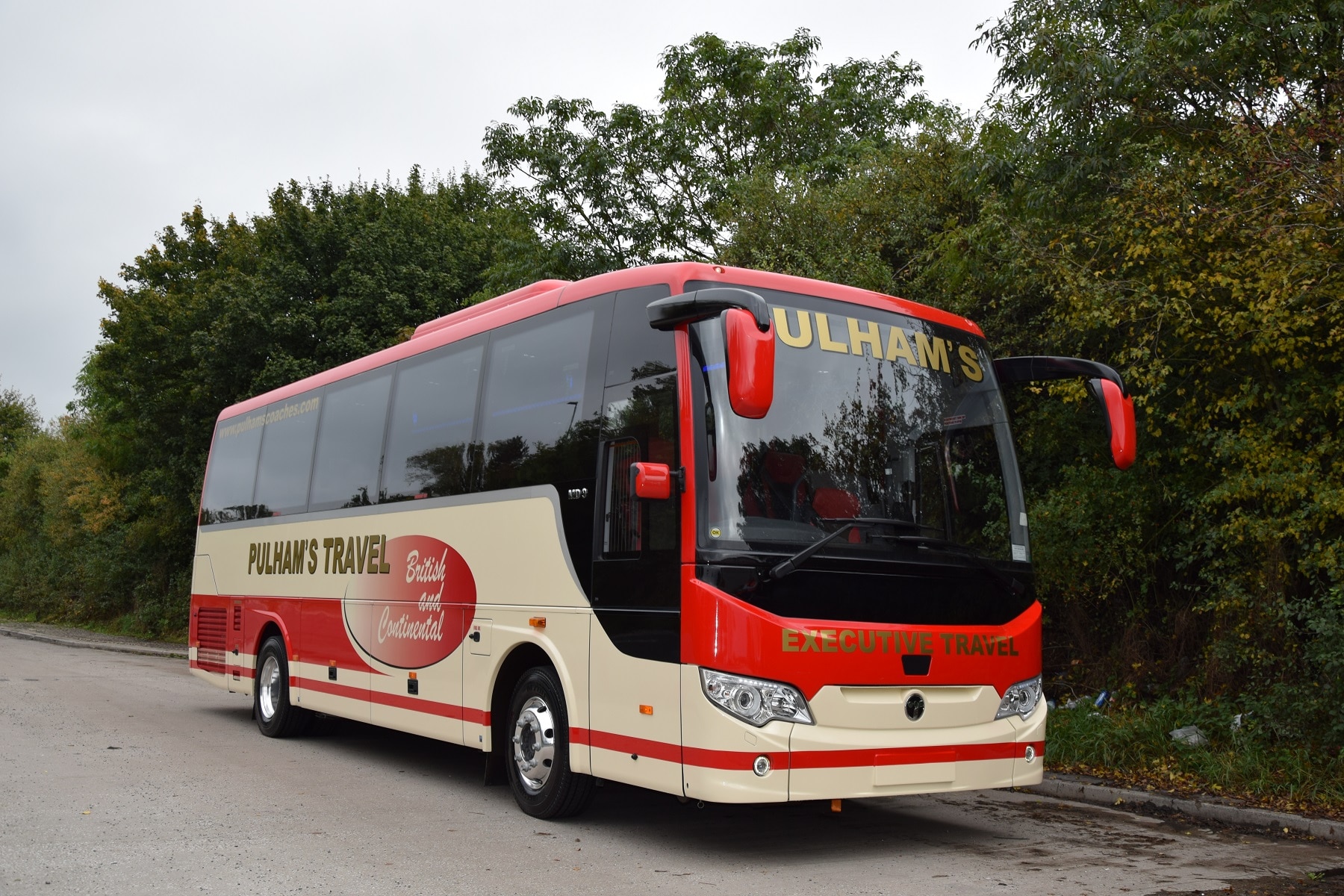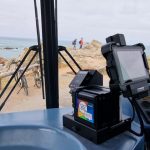Among the attractions at Coach & Bus UK is the revised Temsa range, including the Temsa MD9, shown by Arriva Bus and Coach (ABC). Both models have been updated with the hope of building on their already solid foundations.
The MD9 is Temsa’s midicoach offering. In its latest iteration it has seen various changes, with the most noticeable being to its styling. Within the cabin more minor revisions have been undertaken. That includes to the cab area and to sound insulation.
Dimensions remain largely the same, although the retooled bodywork has extended it by 10cm over the outgoing model.
The new coach retains a second door behind the nearside rear wheel. That maintains a maximum seating capacity of 39, or 34 with a floor-mounted toilet. An accessible variant with a lift within the luggage lockers is available.
Also identical is the driveline. Power is from a Cummins ISB6.7 rated at 280bhp driving through a ZF EcoLife automatic gearbox. Various ‘big coach’ fittings are either standard or optional, including luxury seats. A courier’s position is standard.
Pulham’s Coaches of Bourton-on-the-Water is the first UK operator to place an order for the new MD9. Although ABC will keep the revised model in stock, Pulham’s has been finished as a factory order to its own specification. It arrived last week and represents the Turkish marque’s debut in the Gloucestershire fleet.
Visitors to Coach & Bus UK can see the Pulham’s Temsa MD9 on ABC’s stand. It is among over 80 vehicles at this year’s show. Before that, routeone was given an exclusive look thanks to Director Andy Pulham kindly making it available for a Test Drive.
New Temsa MD9: Fresh look at the front and the rear
The frontal aspect of the MD9 has been updated. While the outgoing model has a crisp enough appearance, the new variant is clearly a development of that. In particular, the lights have been changed completely and the dash is also different.
Perhaps where the greatest alterations have been made is at the rear. Here, too, the lights have been comprehensively updated. The back window is different and includes indicator and brake light repeaters at each upper corner.
Thought has gone into bulb replacement. All four corner panels fold out on hinges; while LEDs are used heavily, they do not form the indicators. At the front, the dash panel can be removed to access the spare wheel.
Chrome window lining has been added. Most other external aspects remain the same as on the outgoing MD9. Luggage locker doors are identical, while the air-conditioning unit stays at the front. Temsa continues to fit a small head-height offside mirror to complement the gullwing arms.
Fuel is added to the 280-litre tank via a filler behind the offside front wheel. At the rear on the same side is AdBlue storage. The radiator is on the offside.
The MD9’s GVW is 14,400kg. To Pulham’s specification, with 34 seats and a toilet, it tips the scales at 9,680kg unladen. It rides on 265/70 R19.5 tyres and is 9.48m long, 2.40m wide and 3.35m high.
Temsa MD9 passenger area comes with variety of options
Innova seats are fitted. Temsa offers a wide range of material, including real or synthetic leather, moquette, flat weave or a mixture.
Pulham’s has specified a flat weave with leather shoulders and headrests. To that has been added drop-down tables, footrests and USB points. The latter are mounted within seat backs.
Also fitted is lateral adjustment for aisle positions. When utilised, it compromises gangway width, as the coach is narrower than a full-sized model. However, it will be welcomed by larger passengers. Red curtains complete the co-ordinated interior look and wood-effect flooring is included.
Accessing the saloon is easy enough. Three steps lead to the platform and they are now edged with LEDs. One more rises to the flat gangway, but it is quite steep.
Access for all
Handrail provision at the front door is good. Twin upright bars are present, and the courier seat base has a horizontal rail. At the rear door the arrangement is not so ideal. Reaching one of the twin handrails when alighting is difficult without stooping.
ABC fits a latest-generation Bosch entertainment unit including a single drop-down monitor. Spheros climate control is standard utilising the roof-mounted unit and perimeter radiators, although no coolant pre-heater unit is present. The toilet cubicle is well-sized and easily reached.
One of the most noticeable aspects for passengers is the lack of noise within the saloon. Even when sat in the rear row and when the door immediately ahead is considered, it is low. The engine can be heard when working hard, but under normal conditions it is almost inaudible.
A servery has been added by AD Coach Systems. The luggage racks are edged in LEDs that illuminate in blue and white, and some seats have downlighting underneath the base. Comprehensive passenger service units are included and a fridge is within the dash.
Cab area is comparable with that in any European coach
The cab layout is comparable with any European coach’s, and the steering wheel now adjusts for reach and rake via a button. It’s easy to get comfortable and the wheel does not obstruct the dash binnacle regardless of its position.
Comfort is aided by the Isringhausen driver’s seat, which in the Pulham’s coach has been trimmed to match those in the passenger area. Twin electric windscreen blinds are fitted. The powered and heated signalling window has a manual blind.
Visibility is reasonable, but the A-pillars are relatively chunky. Additionally, the offside B-pillar is quite far forward. But the mirror arrangement is good, allowing blindspots to be monitored when the lenses are set correctly.
Amenities for the driver include adequate storage locations and USB and cigarette lighter-style charging points. There is room behind the seat for a bag and the button layout is logical, although those relating to the toilet are hidden below the signalling window.
On the road
280bhp in the Temsa MD9 gives a power to weight ratio similar to an 18,000kg GVW coach with 350bhp engine. Performance is what would be expected based on that.
In some scenarios the test coach is keen to change up a gear when waiting another couple of seconds would be beneficial. While the ISB6.7 pulls from around 1,000rpm, it naturally does not do so with the alacrity of engines almost twice its size.
As a result, it is necessary to make use of the kickdown switch occasionally on hills. However, ABC points out that it is an easy task to switch the gearbox’s performance setting to mitigate that.
One positive of the EcoLife is its ability to attain the limited speed on a steep motorway hill in fifth gear. Because of that, it made the climb from Brighouse to Ainley Top on the M62 without dropping speed.
Performance on a flat road is more than adequate, and when tackling a hill from a standing start acceleration is deceptively rapid. Leaving the M62 at junction 22 and heading for Oldham on the A67s gives a steep ascent from a junction, but the MD9 achieved around 38mph before the crest.
The other driving aspects of the new Temsa MD9 are good. It holds the road very well and did a good job of resisting motorway sidewinds. It is also highly manoeuvrable, and the relatively small steering wheel can be spun quickly when required.
Cab environment impressive
Two aspects are particularly impressive: Noise levels in the cab and braking performance. Temsa has achieved the almost-impossible feat of removing wind noise generated by the mirror arms. Couple that to a quiet engine and a well-sealed door, and the cab is almost silent bar tyre noise. Even the indicator warning tone is muted.
Braking is handled superbly. A multi-stage retarder is provided that activates via either the footbrake or the right-hand stalk.
The latter is extremely useful. The coach can be held, and slowed, on even a steep descent solely with the hand control. When dropping into Denshaw on the A672 it brought the MD9 to walking pace on a prolonged downhill stretch without recourse to the footbrake. Such auxiliary braking performance equals any found on larger coaches.
Incremental improvements are the key for new Temsa MD9

ABC values its ability to carry up to 39 passengers. That continues with the new model, which can also be specified with various higher-end fittings if required.
Most of the work undertaken on the MD9 by the manufacturer is cosmetic, but some minor tweaks have been made to its suspension. Soundproofing changes, too, benefit the passenger experience.
Supplier Arriva Bus and Coach believes that the small Temsa is in many ways a scaled-down version of its bigger brother, the HD12. That coach has received a more substantial overhaul, with heavier work on its suspension and the addition of the latest-generation DAF MX-11 engine.
It is true that the MD9 has many attributes of a full-sized coach. The ride is good and noise levels are excellent. Driving it is pleasant and the coach’s auxiliary brake is extraordinarily effective. Luggage capacity is ample for a model in its class and the underfloor area is uncluttered.
If you’re in the market for a midicoach the Temsa MD9 should not be ignored. See it for yourself at Coach & Bus UK 2019.





























